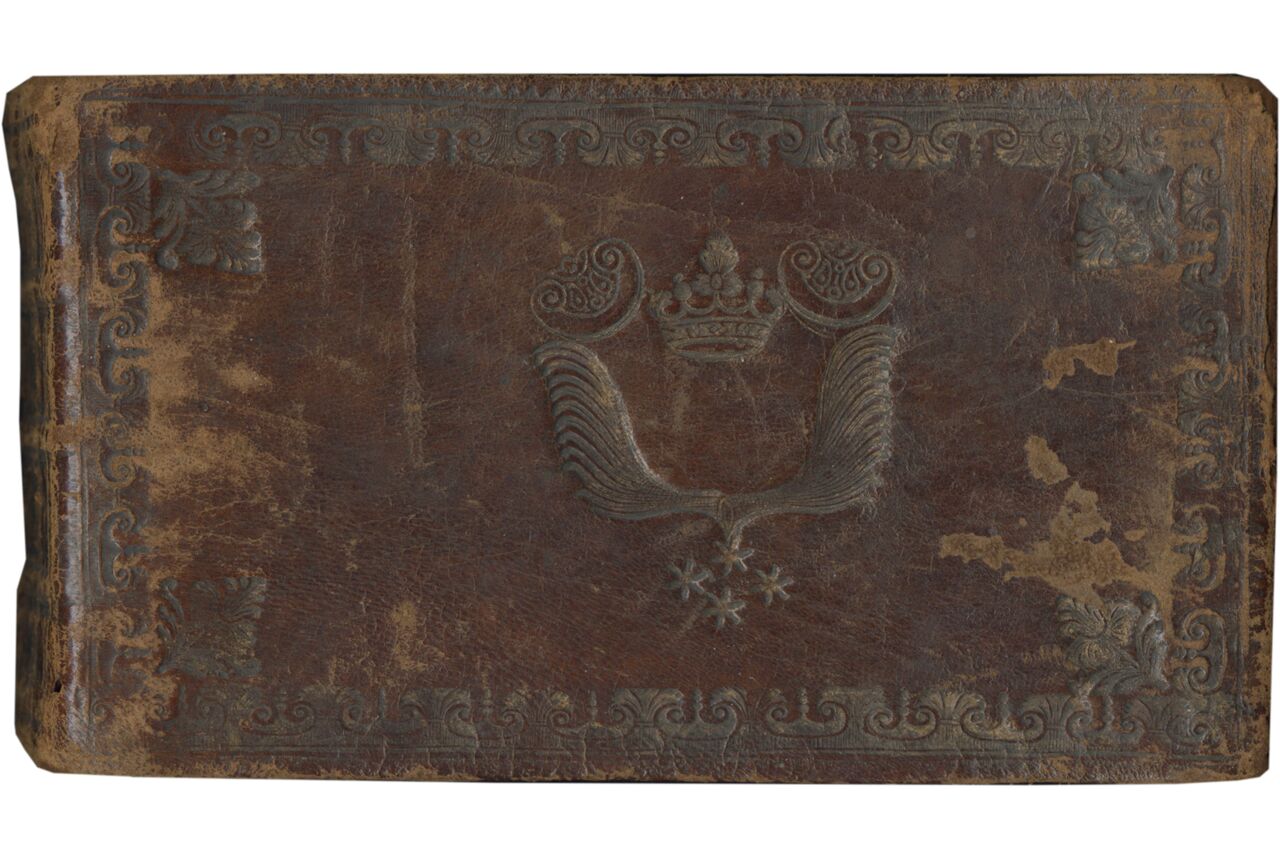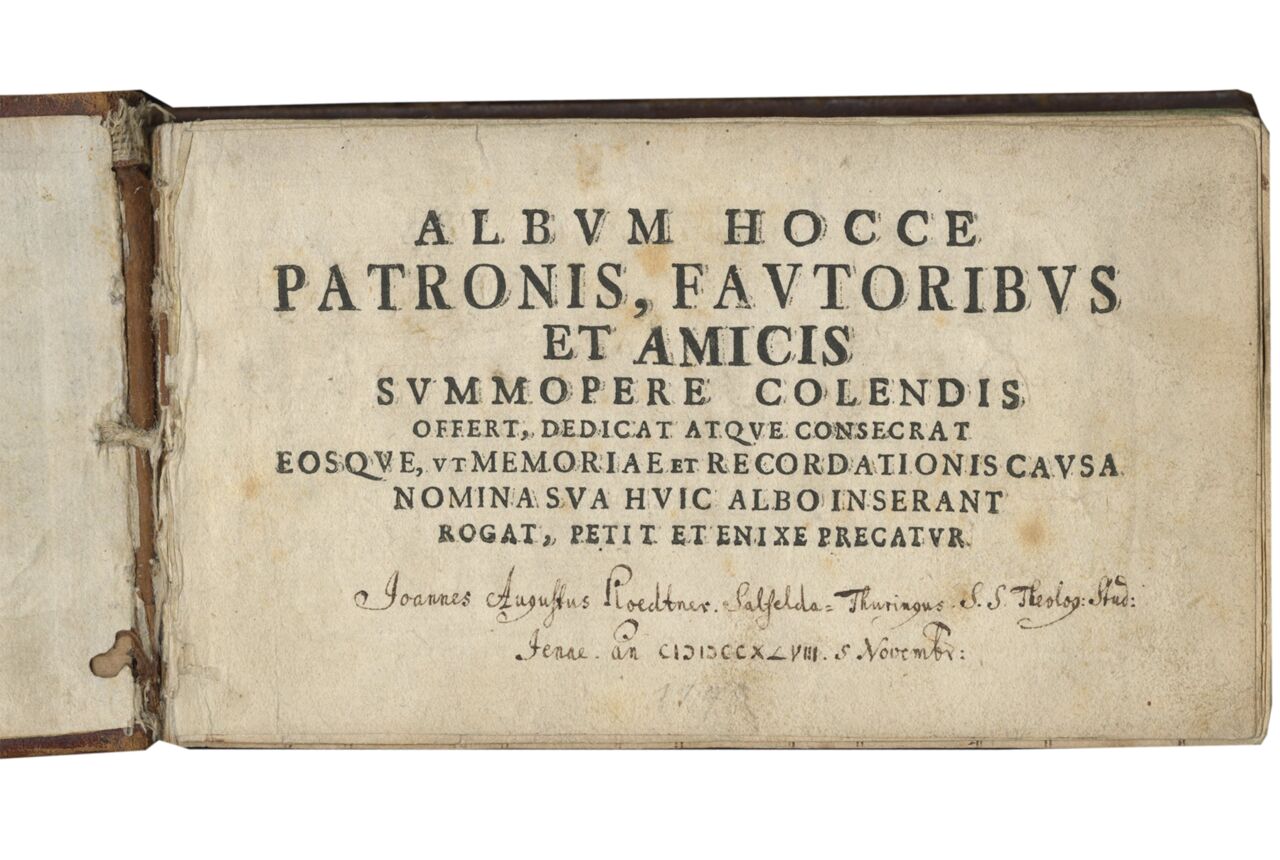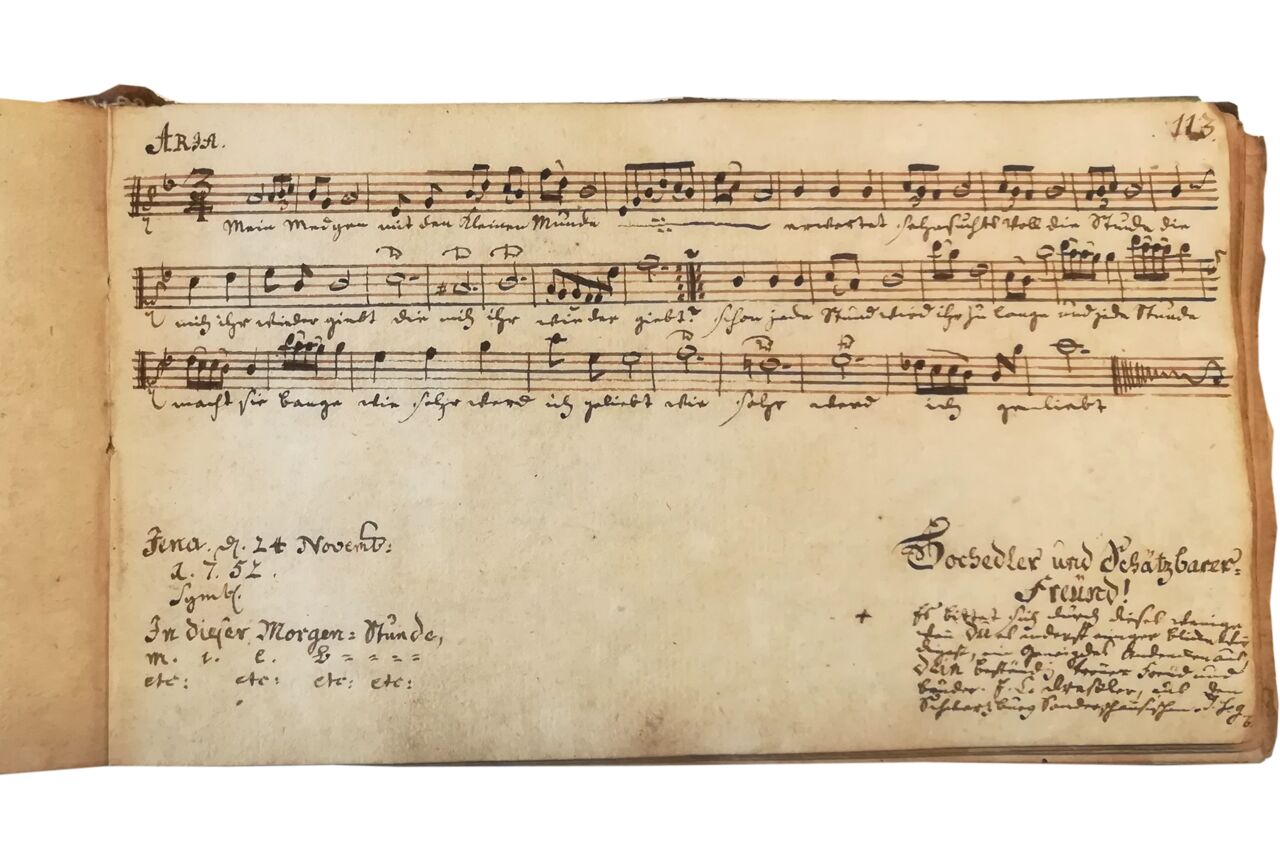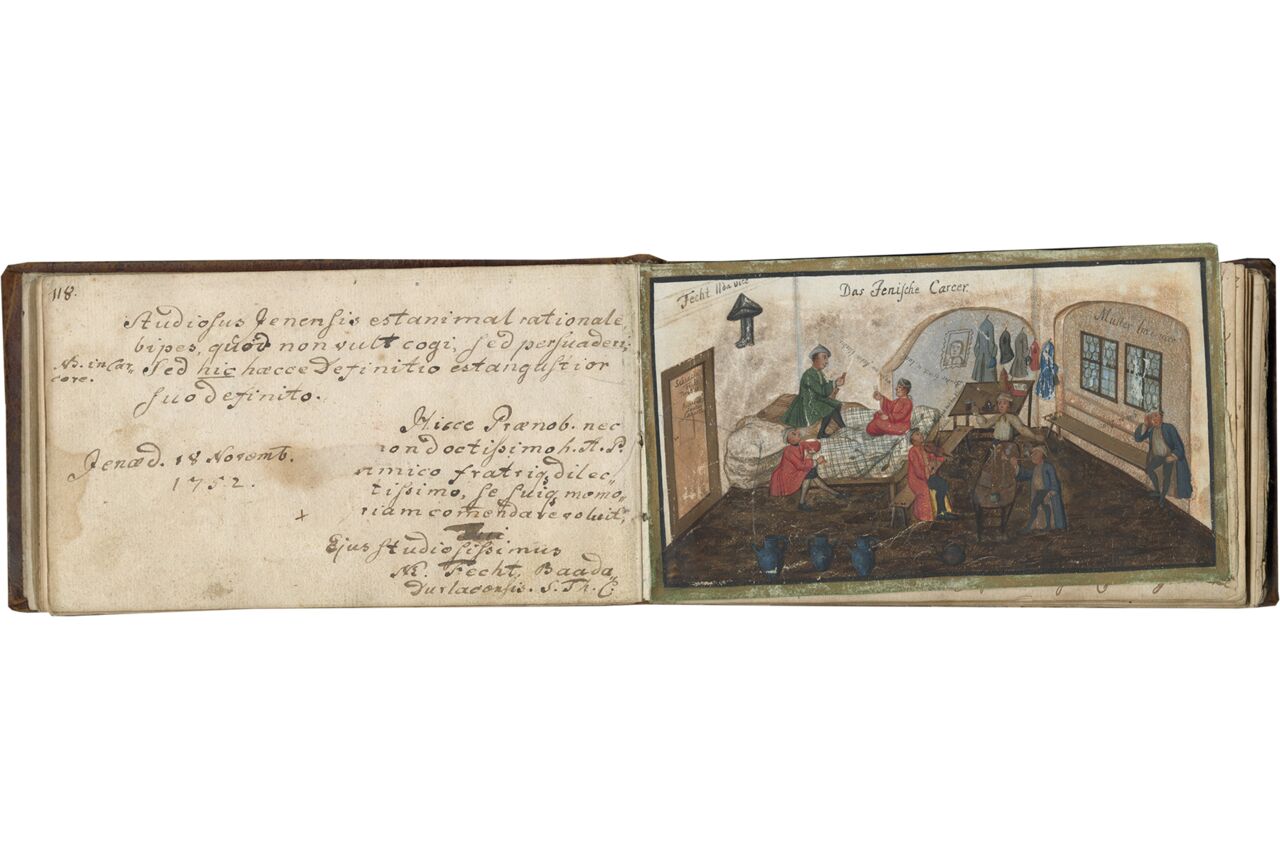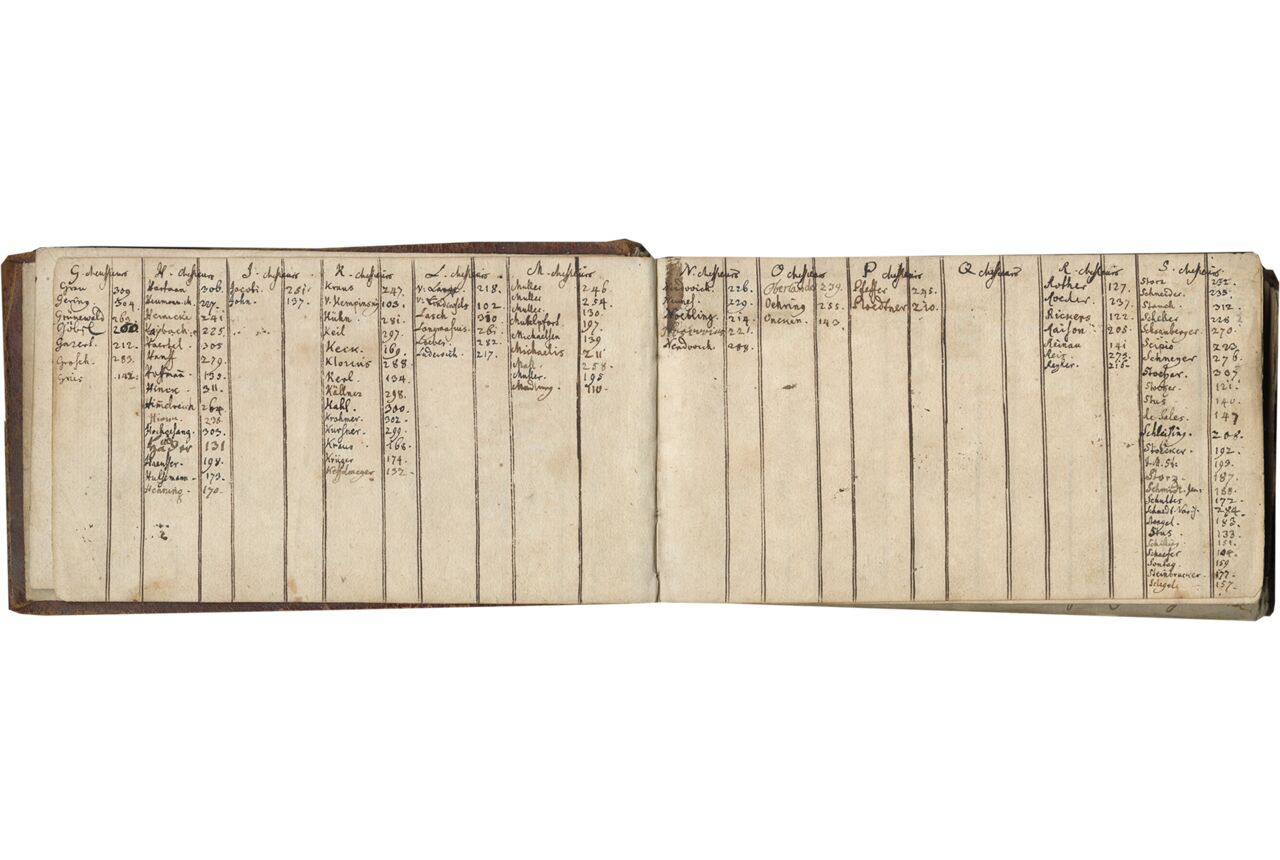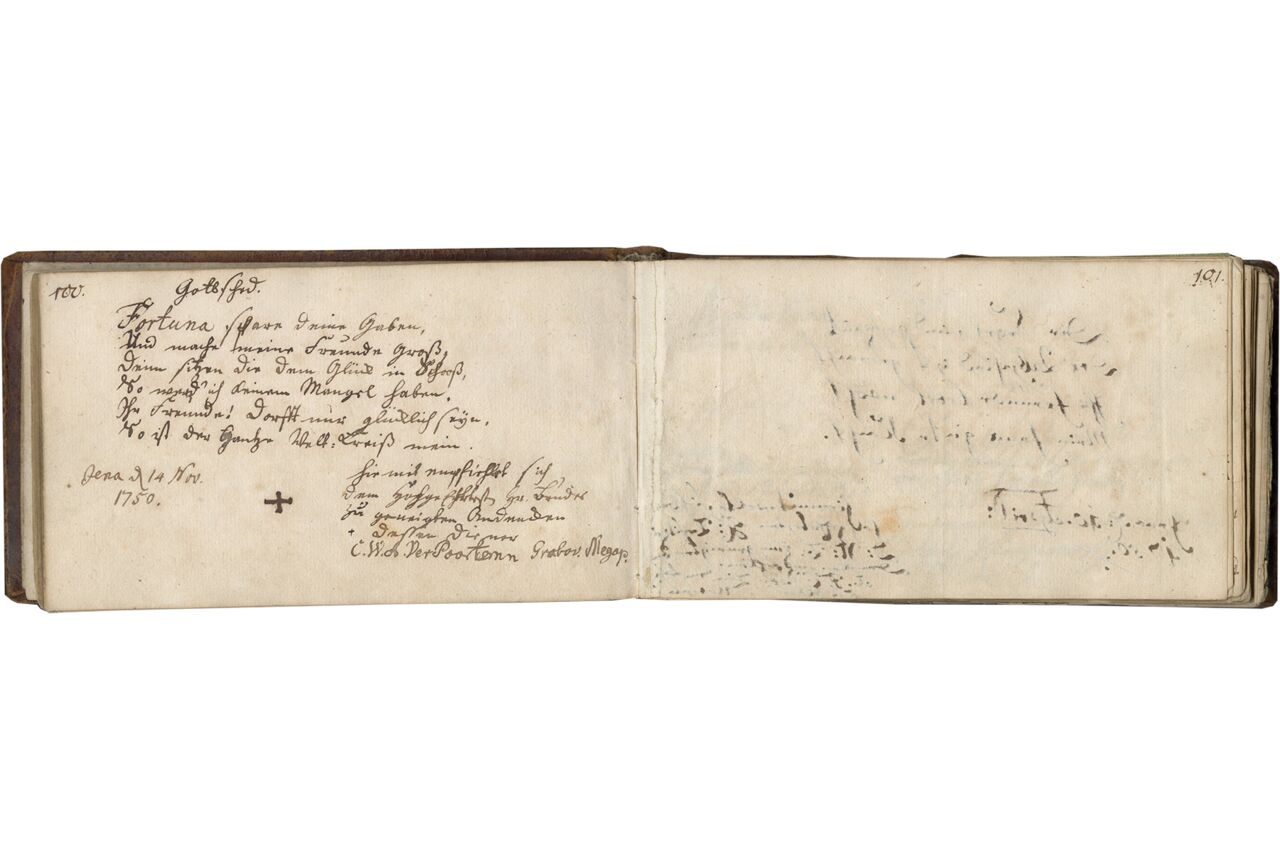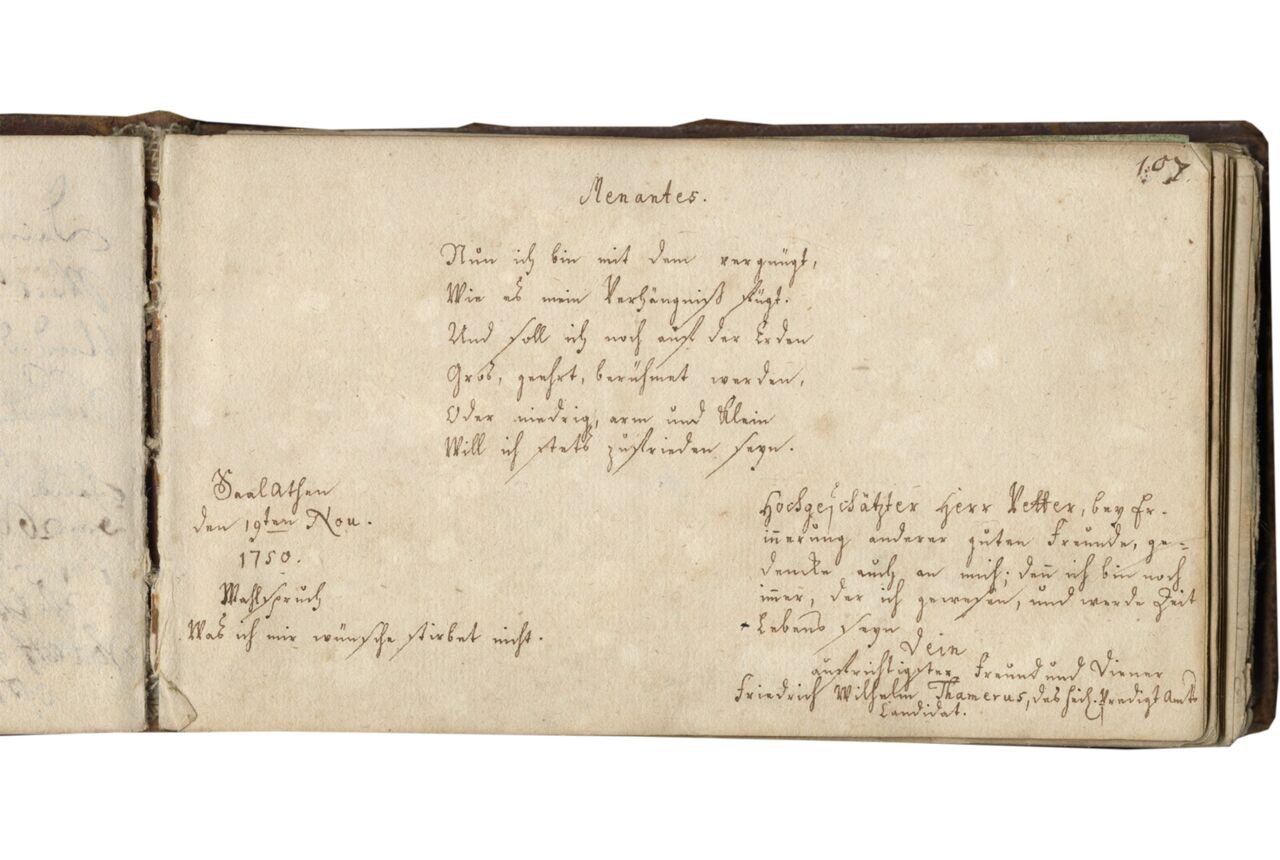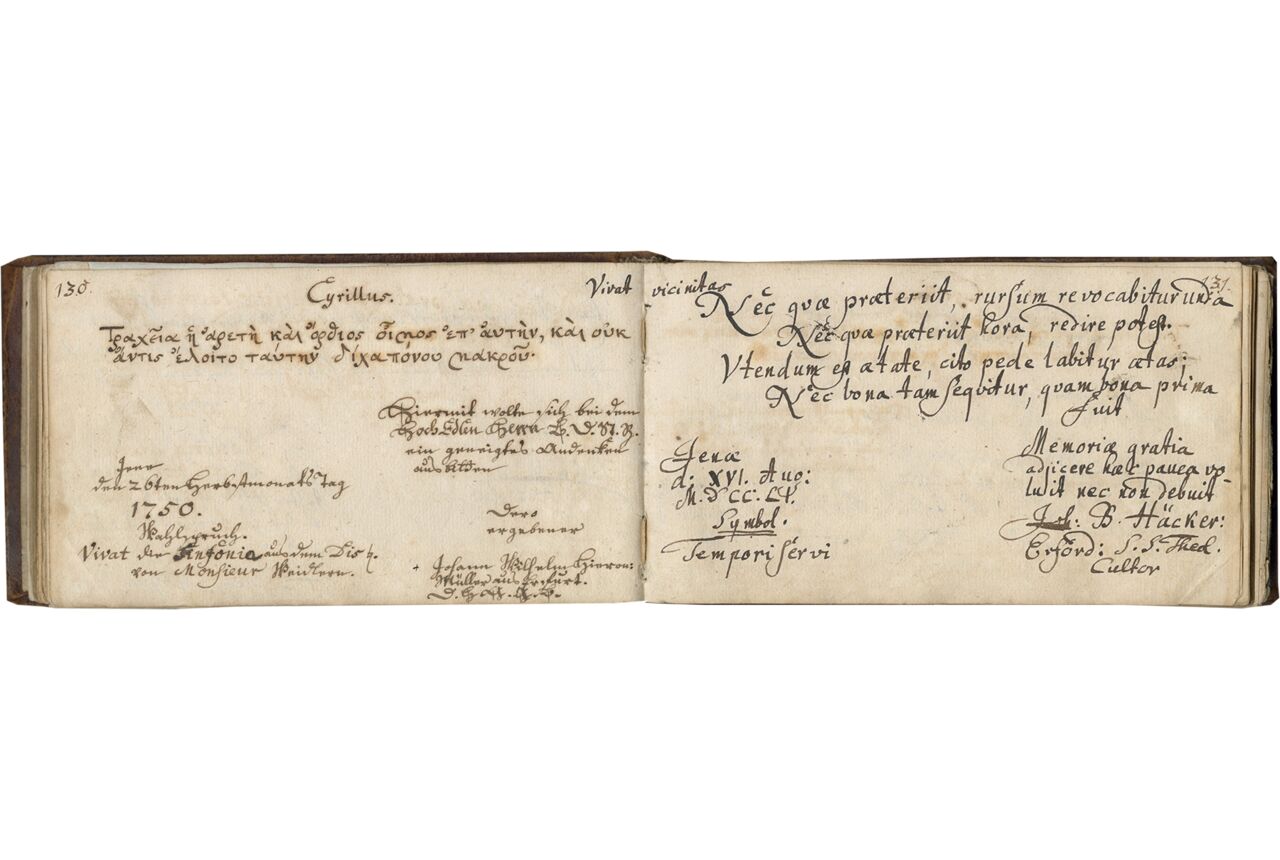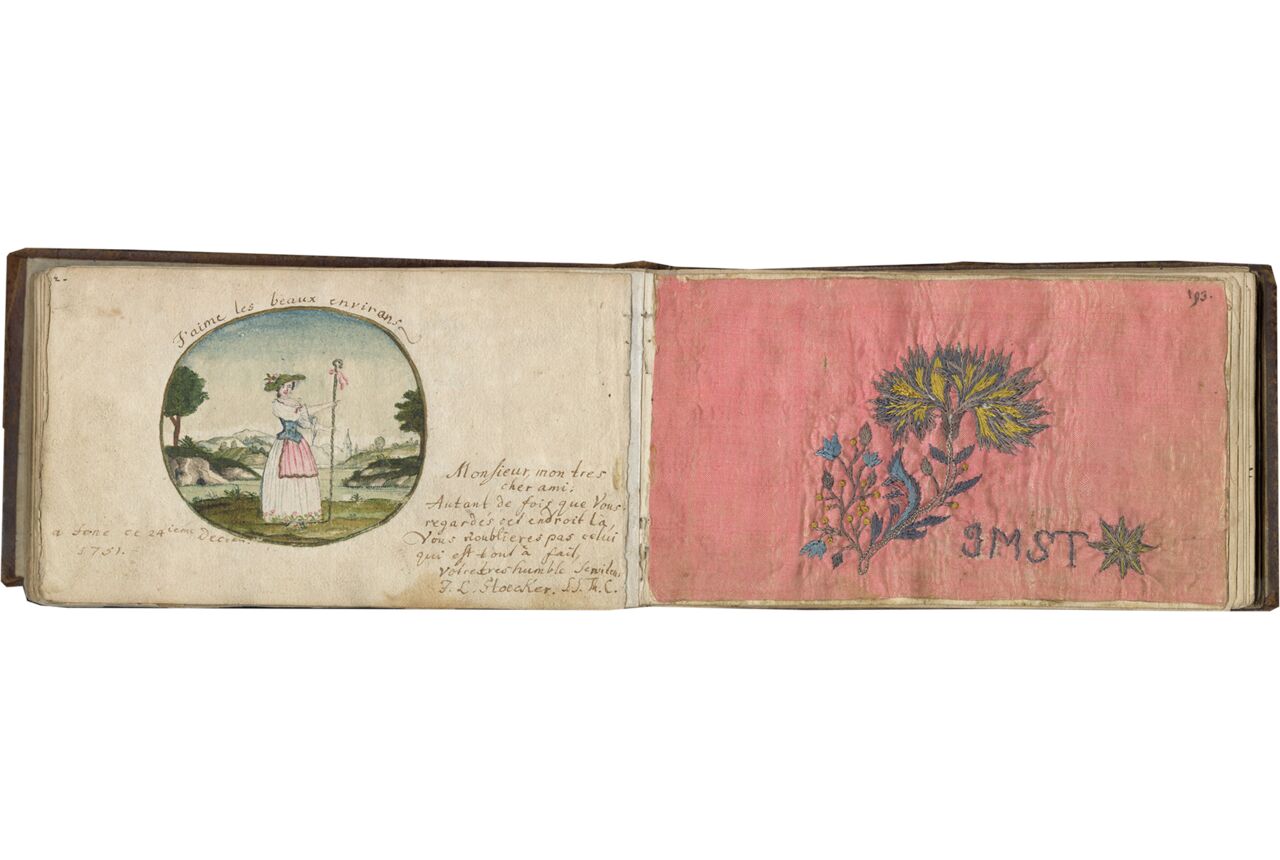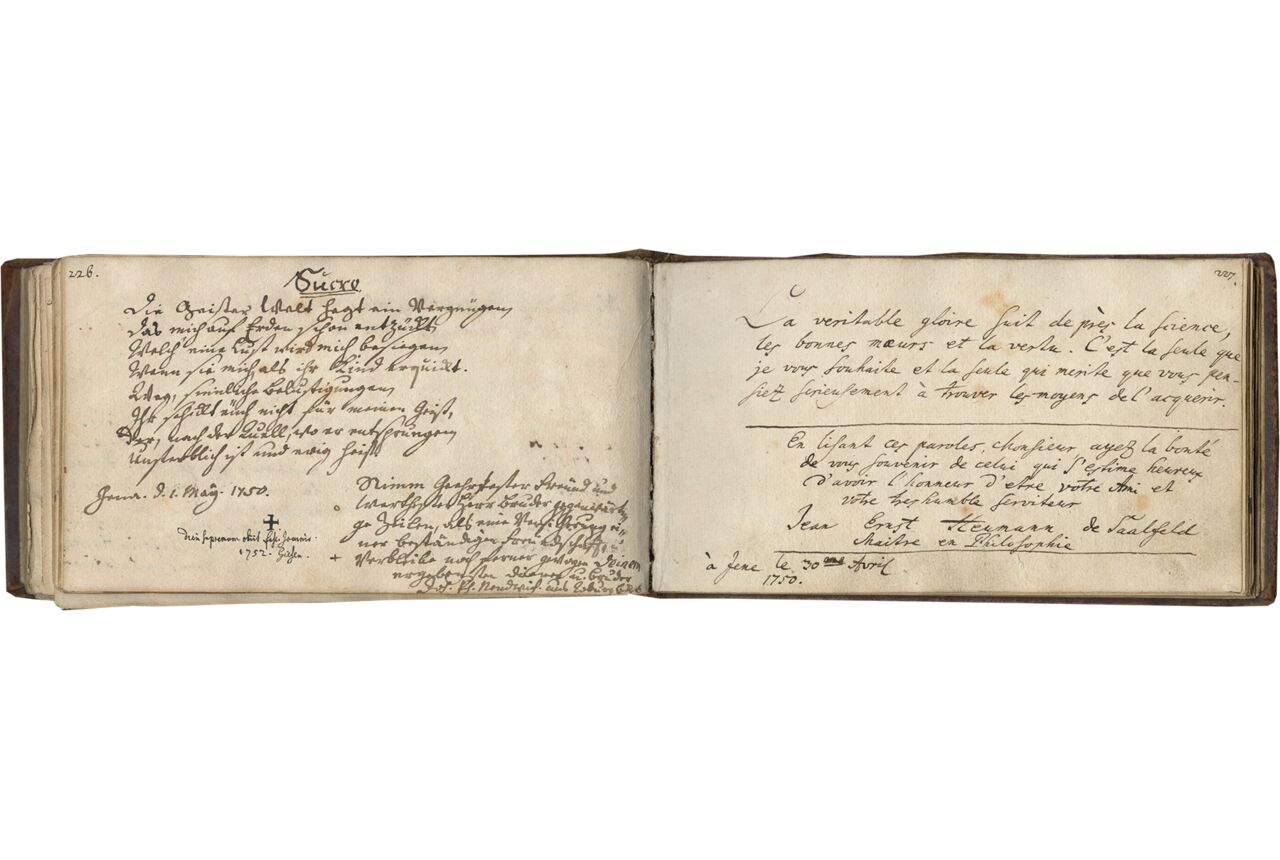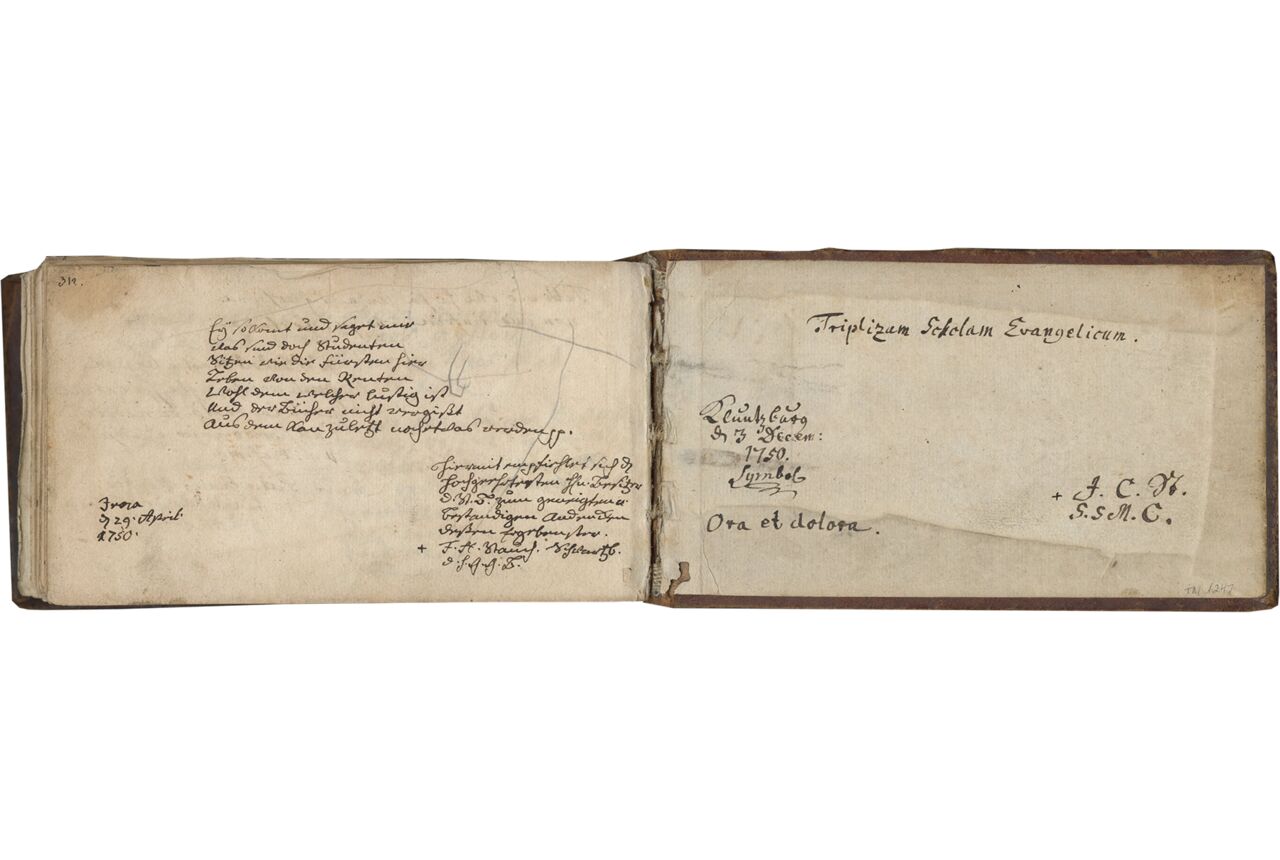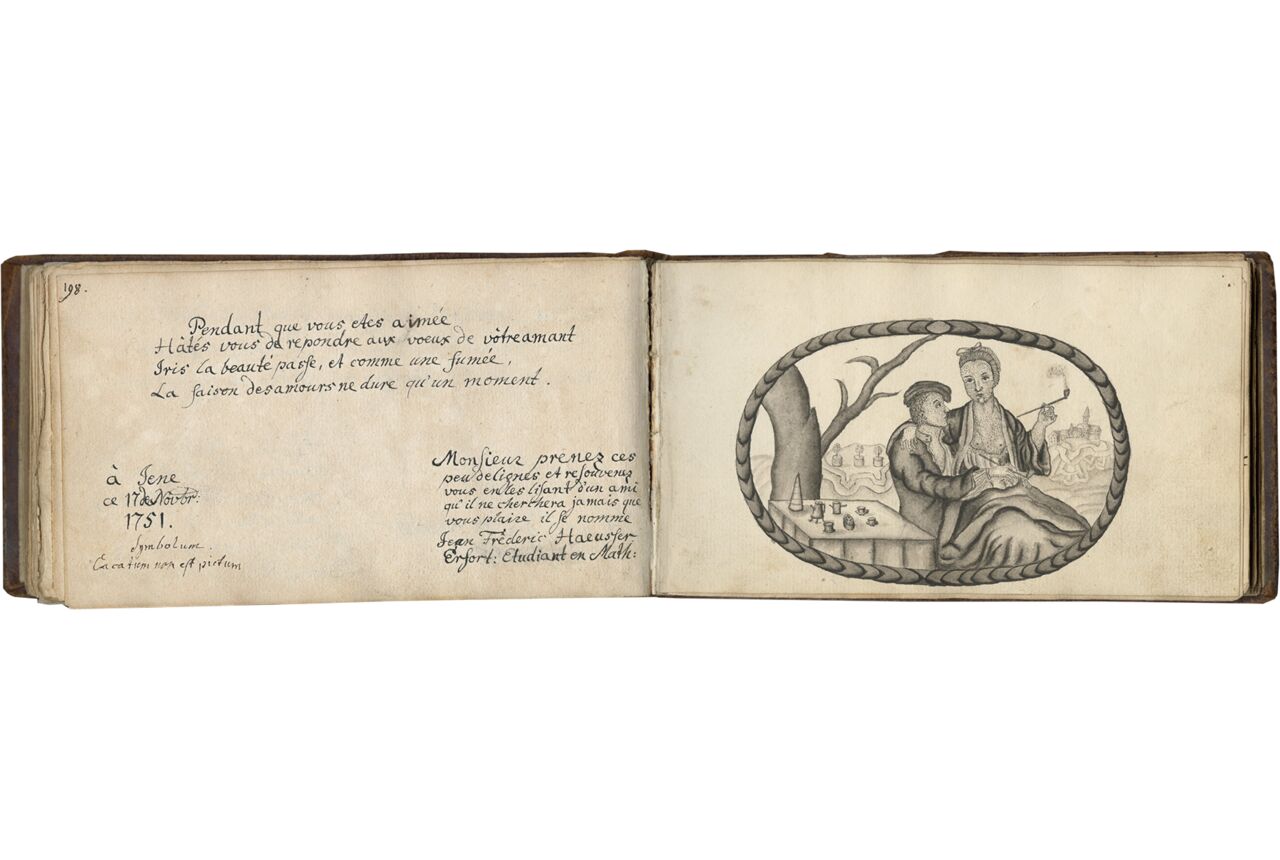160 folios on paper, watermark with a shield surmounted by a crown, with letters ‘H’ and ‘I’, contemporary pagination in brown ink, 1-312 (4 unnumbered leaves in the beginning and 2 unnumbered leaves in between numbered leaves; lacking one leaf corresponding to pp. 189-190), ONE ETCHING, THREE WATERCOLORS, ONE PEN-AND-INK DRAWING WITH WATERCOLOR, ONE GOUACHE WITH PASTELS, ONE EMBROIDERY, the first two leaves and p. 192 loose, a few others almost detached, minor stains, in overall excellent condition. ORIGINAL BINDING of brown calf over pasteboards, gold-tooled with a foliage border, corner fleurons, stamped in the middle of the cover with eagle or swan wings, four stars, a crown, and two broach-like ornaments, flat spine, gilt edges, binding almost detached from the text block, very worn and fragile. Dimensions 99 x 173 mm.
The genre of Album Amicorum (friendship or autograph book), in which associates contributed poems, drawings, sayings, and good wishes, offers us glimpses into social networking in earlier centuries. Each example is unique. The 163 entries in the present album, the property of a theology student, present a historical overview of life at the University of Jena, which flourished as a center of intellectual thought in the eighteenth century. The most important entry is an otherwise unpublished (?) aria by the German operatic singer Ernst Christoph Dressler.
Provenance
1. This is the album amicorum of Johannes Augustus Roedtner, a theology student from Saalfeld in Thüringen, who inscribed his name and the date in brown ink under the printed title on the first (unnumbered) leaf of the manuscript: “Joannes Augustus Roedtner, Salfelda: Thuringus, S.S. Theolog: Stud: Ienae. In MDCCXLVIII. 5 Novembr:” This title page and the conjoined leaf with an etching of students fencing, were made in Jena on November 5, 1748. The 163 entries that follow were made by his patrons, supporters, and friends in 1750-1752, most of them in Jena, and a few in Gotha.
2. A modern bookseller’s note, “107,” in pencil on the front pastedown. A record of this manuscript is published in the “Repertorium Alborum Amicorum” (Online resources).
Text
The first four leaves are unnumbered and contain the titlepage, frontispiece, and list of contents, as follows:
[first unnumbered leaf], Title printed in capitals, “Album hocce patronis, fautoribus et amicis summopere colendis offert, dedicat atque consecrat eosque, ut memoriae et recordationis causa nomina sua huic albo inserant rogat, petit et enixe pregatur”; [followed by Roedtner’s inscription (see Provenance); verso blank; illustration on the second unnumbered leaf (see below)];
[second unnumbered leaf], Illustration (see below);
[third and fourth unnumbered leaves], Alphabetical list of contents by the name of the person who made the entry and the corresponding page number.
[Pp. 1-99, blank; pp. 100-final pastedown] 163 entries, many of which are poems (interspersed with a few blank leaves) in German, French, Italian and Latin, including:
P. 130, entry, headed by the title “Cyrillus,” gives a Cyrillic alphabet of a language that is difficult to identify, perhaps of the glagolitic script, the oldest known Slavic alphabet, created by St. Cyril, a ninth-century monk from Thessalonica;
P. 113, “Mein Medgen [= Mädchen] mit den [sic] kleinen Munde erwartet Sehnsuchts voll die Stunde, die/ mich ihr wieder giebt, die mich ihr wieder giebt. Schon jede Stund wird ihr zu lange und jede Stunde/ macht sie bange. Wie sehr werd' ich geliebt, wie sehr werd' ich geliebt!”;
[Below the date and a dedication to Roedtner, which reveals their close friendship]: “Iena, den 24 Novembris 1752. Symb.(?) In dieser Morgen-Stunde M. I. L. V. etc. etc. etc. etc. Hochedler und schätzbarer Freund!/ Es bittet sich durch dieses Wenige,/ wenn Du es anderst einiger Blicke wür-/digest, ein geneigdes Andencken aus./ Dein beständig teurer Freund und/ Bruder E[rnst] C[hristoph] Dressler, aus dem/ Schwarzburg-Sondershausischen d.h.g. (?)”;
This aria inscribed by Ernst Christoph Dressler (1734-1779), a famous German operatic tenor, violinist, composer, and music theorist, is very likely this album’s most important entry. Like Roedtner, Dressler was a theology student, although his true passion was music, which he would go on to study in Leipzig and Bayreuth, becoming one of the most esteemed singers of Italian opera in Germany. He worked as a singer at several courts, including the Imperial Court Opera in Vienna and the court opera in Kassel, where he remained until his death. Dressler is best known for a march which was the basis of Beethoven’s earliest work, published three years after Dressler’s death. Dressler published two songbooks, Melodische Lieder für das schöne Geschlecht in 1771, and Freundschaft und Liebe in 1774. Two decades earlier, on 24 November 1752, Dressler inscribed the following aria in our manuscript (p. 113; we are grateful to Marc Smith for his help with the transcription):
The aria is not included in either of Dressler’s published songbooks nor does it appear to be published elsewhere. It may well be a hitherto unknown piece of music by this important eighteenth-century singer and composer.
P. 245, Four-line poem with an eight-line dedication to Roedtner and the date March 24, 1752, appears to be by Christian Wolff (1679-1754), one of the most eminent German philosophers between Leibniz and Kant. Wolff had studied mathematics, physics and philosophy at Jena, before becoming, in 1706, professor of mathematics and philosophy to the University of Halle. According to Voltaire, Wolff’s lectures attracted around a thousand students from all over.
Other contributors to this album amicorum include Beckman, Boettner, Buchka, Bieber, Bayes, Cranes, Conradi, Erdmann, Eckens, Erbe, Faustus, Faber, Fischer, Fecht, Francke, Gering, Grünewald, Henning, Jacobi, John, Kraus, Kühn, Keil, Krüger, Lange, Muller, Mall, Noebling, Oncken, Pfeffer, Rother, Rickers, Raison, Scheller, Scipio, de Sales, Sontag, Trier, Vogel, and many others. They provide a wealth of material for studying the leading intellectuals who gravitated toward the University of Jena in the mid-eighteenth century.
Illustration
[second unnumbered leaf], Fine etching printed in reddish brown ink, illustrating two students dueling on the Jena Market Square, entitled “Prospect Des Jenischen Marckts”;
p. 119, Very interesting mixed media work applying gouache painting and pastels; it illustrates a Karzer, a detention room used for incarcerating students as a punishment; the image is entitled “Das Jenische Carcer” and shows students in a large room smoking, playing cards, and one playing a violin; there are several fascinating details of the interior, dress, furniture, and various artifacts, including a coffee pot, cups, books and a candle on the tables, three large pitchers and a tea pot on the floor, student coats, hoods and a framed portrait hung on the wall, crown glass windows, and inscriptions commenting on the picture and three lines of conversation emanating a card-player, the fiddler and a smoker in tiny, neat handwriting; the border of the image is painted in liquid gold; the painting is on thick paper that is pasted onto the leaf;
p. 186, Watercolor illustrating a finely attired reclining woman with her hand on her belly, and at her side is a doctor in a red cloak holding a urine flask and pointing to her stomach, indicating that she is pregnant; a blindfolded angel to the right points to a list of names arranged in columns;
p. 192, Very fine watercolor illustrating a young woman in a country landscape wearing a finely tailored gown and a hat with flowers who holds an ornate crook walking cane decorated with a pink ribbon; the painting takes the form of a medallion with a thin golden frame and is accompanied by inscriptions: “J’aime les beaux environs,” “a Jena ce 24ème Decembre 1751,” and “Monsieur mon tres cher ami: Autant de fois que Vous regardés cet endroit là, Vous n’oublierés pas celui qui est tout à fait, votre tres humble serviteur J. L. Stoecker. S.S.Th.C.”;
p. 193, Very fine embroidery on pink silk made with sparkling silk threads in silver, light blue, pink and yellow illustrating a delicate cluster of flowers and initials “JMST” followed by a star;
p. 199, Pen and ink drawing with washes in grey tones illustrating a couple seated next to a table in a landscape smoking; the woman sits on the man’s lap and her chest is uncovered; on the table are placed tiny coffee cups, pots and three curious containers apparently for food; the painting is in the form of an oblong medallion; on the facing page, a poem: “Pendant que vous etes aimée/ Hâtés vous de repondre aux voeux de votre amant/ Iris la beauté passe, et comme une fumée,/ La saison des amours ne dure qu'un moment” ;
p. 204, Extraordinarily arresting framed watercolor illustrating a lady in a fine dress and gloves imprisoned in a birdcage placed on a checkered floor resembling a chessboard, and behind her are two sculptures or chess pieces; on the left is a vista with a fountain, ornamental flower beds, a procession of trees and in the distance a palace; the scene is in a circular gold frame enlaced with a red ribbon and augmented with foliage; the framed image is set against a peach-toned ground under a dramatically draped red curtain; on the facing page is a ten-line poem in French by Mr. Raison, beginning “Quelque fois au feu qui la charme, Resiste une jeune beauté... et l’honneur de passer pour chaste, La refoul à l’être en effet.”
The University of Jena was founded in 1558 as a home for the new religious opinions of the sixteenth century. Enrollment peaked in the eighteenth century and by the end of the century the university was attracting some of the most influential thinkers of the time and had become the center of the emergence of German idealism and early Romanticism. The University of Jena allowed its students to duel, and this traditional academic fencing, known by the German technical term Mensur, is illustrated in the beginning of the manuscript. The objective of the Mensur was not to win or to avoid injury, but rather to endure it stoically as a traditional way of training and educating character and personality. The term Mensur referred to the specified distance between each of the fencers, which they were meant to maintain throughout the duel. Traditionally the duelers wore no protection, as seen in our manuscript. Another historical aspect specific to German universities was the use of Karzers, designated detention rooms for students, which existed until the beginning of the twentieth century. Our manuscript includes a fascinating illustration of the Karzer at the University of Jena, which is one of the few Karzers that is still preserved today (p. 119 in our manuscript).
The album amicorum, or album of friends, was typically compiled by young aristocrats, who collected entries from their circle of friends, professors, supporters, colleagues, relatives and acquaintances during their travels and studies. It was mainly popular among men. The 163 entries in this album show how during just two years Johannes Roedtner managed to create an extraordinarily large social network while pursuing his theology studies in Jena. The large number and variety of the entries (carefully listed at the beginning, which is unusual) make this manuscript a wonderful source for researching eighteenth-century social history.
The album amicorum is an invaluable resource for modern transdisciplinary research on texts, reception and collecting in cultural and social contexts and the history of mentalities; see especially the comprehensive study by Werner Wilhelm Schnabel published in 2003. The albums were made from the sixteenth until the nineteenth century, and throughout their history they usually assumed an elongated horizontal format, as is the case for our manuscript.
Literature
Fechner, J.-U., ed. Stammbücher als kulturhistorische Quellen, Wolfenbütteler Forschungen 11,
Munich, 1981.
Keil, R. and R. Die deutschen Stammbücher des sechzehnten bis neunzehnten Jahrhunderts. Ernst und Scherz, Weisheit und Schwank in Original-Mittheilungen zur deutschen Kultur-Geschichte, Berlin, 1893 (reprint Hildesheim, 1975).
Klose, W. “Stammbücher: eine kulturhistorische Betrachtung,” Bibliothek und Wissenschaft 16 (1982), pp. 41-67.
Kurras, L. Zu gutem Gedenken. Kulturhistorische Miniaturen aus Stammbüchern des Germanischen Nationalmuseums 1570-1770, Munich, 1987.
Lilienthal, M. Schediasma critico-literarium de philiothecis varioque earundum usu et abusu, vulgo von Stamm-Büchern, Königsberg, 1712; rev. Wittenberg, 1740 (repr. in Fechner, 1981, pp. 237-298). [the first study of Alba Amicorum].
Nickson, M.A.E. Early Autograph Albums in the British Museum, London, Trustees of the British Museum, 1970.
Rosenheim, M. The album amicorum, Oxford, 1910.
Schnabel, W. W. Das Stammbuch: Konstitution und Geschichte einer textsortenbezogenen Sammelform bis ins erste Drittel des 18. Jahrhunderts, Berlin, 2003.
Schünemann, H. “Stammbücher,” Schrifttumsberichte zur Genealogie und zu ihren Nachbargebieten 2 (1965), pp. 67-108.
Taegert, W. Edler Schatzholden Erinnerns: Bilder in Stammbüchern der Staatsbibliothek Bamberg aus vier Jahrhunderten, Bamberg, 1995.
Online Resources
“Repertorium Alborum Amicorum”? https://raa.gf-franken.de/de/startseite.html
Including Our manuscript
https://raa.gf-franken.de/de/suche-nach-stammbuechern.html?permaLink=1750_roedtner
Ernst Christoph Dressler (1734-1779) https://en.wikipedia.org/wiki/Ernst_Christoph_Dressler
Ernst Christoph Dressler, Melodische Lieder für das schöne Geschlecht in 1771
https://books.google.fr/books?id=ar1GnQEACAAJ&printsec=frontcover&hl=fr&source=gbs_ge_summary_r&cad=0#v=onepage&q&f=false
Christian Wolff (1679-1754) https://en.wikipedia.org/wiki/Christian_Wolff_(philosopher)
University of Jena https://en.wikipedia.org/wiki/University_of_Jena
TM 1247


